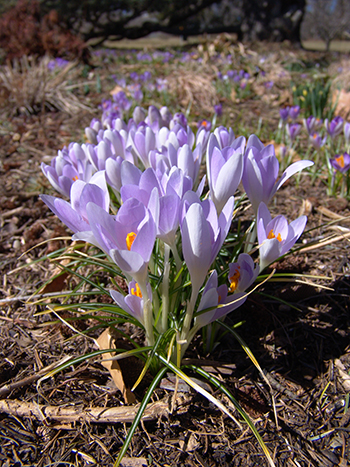Plants of the Week: April 13
Crocus tommasinianus
The Cherry Border is currently overflowing with these early bulbs. The color is a clear, light, faded purple that seems to have an ethereal glow, each with a spark of deep orange making up the reproductive parts. Each year in early spring the flowers emerge singly along with the foliage from a bulb-like corm. By April they are usually gone for the year. Taxonomically, as a member of the Iridaceae family, the crocuses are suggested as being closely related to irises and are native to south-eastern Europe. photo credit: R. Robert
Mahonia ‘King’s Ransom’
Mahonia is often used for its evergreen leaves and strong textural characteristics. The leaves of ‘King’s Ransom’ emerge a cloudy blue-green and turn an attractive leather-like purple in the fall. It blooms in spring with sweetly scented bright yellow flower clusters that mature to sour, edible, grape-like fruits; hence the common name: Oregon grape-holly. Though a lovely and versatile piece in the garden, it can be particularly susceptible to winter burn. A lively stand can be found at the Meetinghouse. photo credit: J. Bickel
Sciadopitys verticillata ‘Winter Green’
Passing this specimen frequently, I mistook it for a member of the pine genus when, in fact, though placed in the order Pinales, Sciadopitys is actually quite different. DNA research has revealed that this genus has no extant close relatives and has been placed it in its own family Sciadopityaceae. The long, thick, needle-like structures are borne in whorls along the branches instead of fascicles (like Pinus), creating the appearance of umbrella skeletons; thus giving it the common name umbrella pine. Also, the needles are composed of photosynthetic branch material instead of leaf material like pine needles. The ‘Winter Green’ cultivar was selected for its dark green winter foliage and pleasant conical branching habit. photo credit: J. Bickel






![Mahonia aquifolium 'King's Ransom' JTB [1]](https://www.scottarboretum.org/wp-content/uploads/2015/04/Mahonia-aquifolium-Kings-Ransom-JTB-1.jpg)
![Sciadopitys verticillata 'Winter Green' JTB [1]](https://www.scottarboretum.org/wp-content/uploads/2015/04/Sciadopitys-verticillata-Winter-Green-JTB-1.jpg)
No Comments